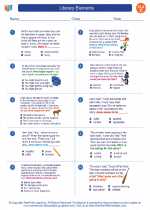Understanding Quantitative Adjectives
Quantitative adjectives answer the question "How much?" or "How many?" and give specific information about the quantity of a noun. They can be used to describe both countable and uncountable nouns.
Examples of Quantitative Adjectives
Some common examples of quantitative adjectives include:
- few, many, several, all, some, any, much, little, more, most, enough, half, whole, both, several, no, one, two, three, etc.
These words give us information about the quantity of the noun they are describing.
Using Quantitative Adjectives in Sentences
Quantitative adjectives can be used to add detail to sentences and make your writing more specific. For example: - There are several books on the shelf. - She has enough time to finish her homework. - He ate half of the pizza. - Both of the dogs are sleeping.
Countable and Uncountable Nouns
It's important to understand whether a noun is countable or uncountable when using quantitative adjectives. Countable nouns are things we can count (e.g. books, cars, students), while uncountable nouns refer to things that cannot be counted individually (e.g. water, sugar, air). Quantitative adjectives are used differently with countable and uncountable nouns.
Study Tips
Here are some tips to help you study and understand quantitative adjectives:
- Make a list of quantitative adjectives and their meanings.
- Practice using quantitative adjectives in sentences with both countable and uncountable nouns.
- Identify quantitative adjectives in reading passages or texts to see how they are used in context.
- Quiz yourself or ask a friend to quiz you on the use of quantitative adjectives.
- Write short paragraphs using quantitative adjectives to describe different objects or situations.
◂English Language Arts Worksheets and Study Guides Third Grade. Literary Elements

 Worksheet/Answer key
Worksheet/Answer key
 Worksheet/Answer key
Worksheet/Answer key
